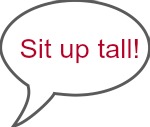 What sets humans apart from other mammals is our ability to express ourselves with spoken language.
What sets humans apart from other mammals is our ability to express ourselves with spoken language.
However it can make our lives considerably more complicated, especially when it comes to learning to ride!
Take a few common phrases, and as you read them, what do they mean to you?
“Sit up tall”
“Sit deep”
“Relax”
“Wait for the fence”
“Make your horse rounder”
The list could go on, with language that we frequently hear, both in lessons, and written in magazines and books. I expect that each phrase means something to you, and you would be able to explain how, with a great deal of passion!
Why is this a problem?
However, there is a problem, because each of us is different, and our bodies all have different starting places, meaning that for each of us, an instruction is going to mean something different.
Also, these phrases have been handed down from instructor to instructor, rider to rider, and no one really knows what was meant by the person who first said them.
Lets look at “sit up tall” as an example. As you read this, I want you to picture yourself on your horse, sitting up tall, and now go through the motions. How do you “sit up tall”?
Do you stretch yourself up? Do you roll your shoulders back? Do you lift your chest? Do you pull your tummy in? Do you lean back?
These are all things we might do when told to “sit up tall”.
Lets imagine that many years ago, a very talented rider, Frank, discovered that when he adjusted his upper body in the saddle, his horse’s way of going instantly improved. It felt, to him, as if he was ‘sitting up tall’ so when his students arrived for their next lessons, he naturally wanted to teach them this skill, and so he said to them all ‘now, sit up tall!’
Each of his students “sat up tall” and interpreted the instruction as best they could. For a few, it worked really well, and Frank was pleased with his discovery, but for those for which it didn’t work, they were somewhat confused and left wondering if they were getting it right.
The problem with riding, is that we generally refer to talented riders to tell us how to do it. I call this a problem, because talent is something that you are born with, and is not easy to pass on.
Think of a riding skill like an iceberg. The iceberg below the water represents the unconscious part of the skill, i.e., the part of the skill that we can perform without having to think about it. The iceberg above the water, (usually only a very small fraction), represents the conscious part of the skill that we are aware of and can consciously describe and/or alter.
When Frank discovered his “sit up tall” skill, it is highly likely that most of its components were buried in his subconscious competence or talent, and already ticking over on auto-pilot (iceberg below the waterline), and that the additional component that made the skill very effective, was new to him, and therefore very real to him in his conscious foreground, (iceberg above the waterline)
For Frank to pass on all the necessary components of how to make horses go better by “sitting up tall”, he would have to explain not only his recent discovery in his body, but also exactly what else his body is already doing when he is riding (on auto-pilot!), and then he would have to describe it in such a way that everyone could recreate it just like he does!
This presents a huge problem, because breaking down an unconscious skill into learnable chunks is hard work and very time consuming, and there is always the risk that as you break down the skill, you could even lose it yourself and have to re-learn it! And who wants to risk that?
So, good riding, the ability to naturally make a horse go well, becomes a skill that is elusive to many, because their tone, balance, strength, confidence, focus is so different to that of their talented teachers, that there is little chance of them bridging the gap, unless they are given the components of talent in learnable, bite-size chunks.
That is not to say that there aren’t many brilliant teachers out there working hard from their hearts to improve their students riding.
So, back to “sitting up tall”, and what it really is!
Well, how can I say that, without seeing your starting point?
For me, it means organising my pelvis so that my seatbones are pointing down, filling out the hollow in my lower back, engaging my core muscles to stabilise me, dropping my shoulder girdle down to connect with my ribcage, closing the back of my armpits, filling out my ‘lats’, and breathing!!!! Then I look my tallest, and my horse likes it too! It even makes me look ‘talented’, when I get it all together! However, it would be no good me teaching this to you, as this if for my body and its inherent traits, and is my own personal “sit up tall” recipe.
This is not the end though, because even if we can learn a new skill in appropriate bite size chunks, tailored to our needs, explained in our own language, there is still a big challenge of overcoming the ‘weirdness’ in our bodies of how the new position feels, but that is another blog!

